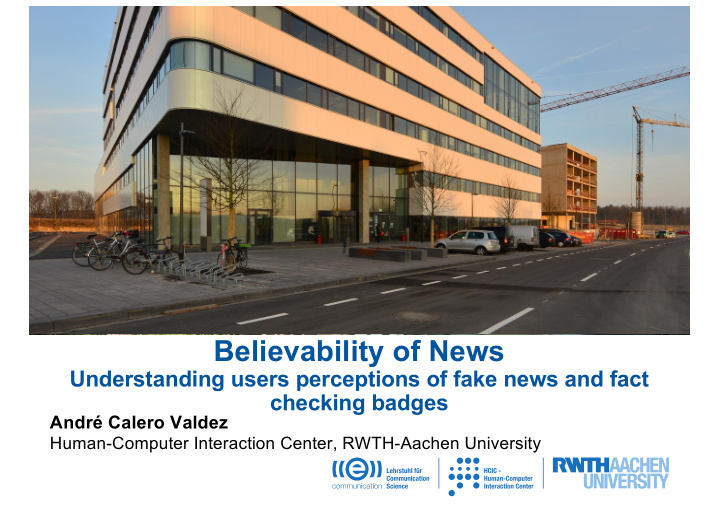



Believability of News Understanding users perceptions of fake news and fact checking badges André Calero Valdez Human-Computer Interaction Center, RWTH-Aachen University
Fake News - Definition • What exactly are fake news? • They are not: - Poor politics - Poor journalism - Click-Baiting - Accidental Falsehoods - …
Satire
Fake News - Definition • What exactly are fake news? • They are: - Desinformation § Purposefully harmful • Forms: - Misinterpreted Content § Decontextualized - Manipulated Content - Fabricated Content - As news or memes
What is the problem? • Fake news spread further and faster than real news Vosoughi, S., Roy, D., & Aral, S. (2018). The spread of true and false news online. Science, 359(6380), 1146-1151. • They are (un-)intentionally used by people, organizations, institutions Lazer, D. M., Baum, M. A., Benkler, Y., Berinsky, A. J., Greenhill, K. M., Menczer, F., ... & Schudson, M. (2018). The science of fake news. Science, 359(6380), 1094-1096. • Bots are often utilized to further spread fake news Shao, C., Ciampaglia, G. L., Varol, O., Yang, K., Flammini, A., & Menczer, F. (2017). The spread of low- credibility content by social bots. arXiv preprint arXiv:1707.07592.
Are the users to blame? • Fake news often cater to the users strongly held beliefs - Confirmation Bias - Filter-Bubbles, Echo Chamber, Cyber-Balkanization - Users share news without reading them • Fake news target extremist perspectives - Far left, far right - Increased perceptions of polarization => Decrease in political discourse • Research Questions: - But who believes fake news? - Can users be assisted in detecting fake news?
Method Survey study (n=143) • Rate believability of news items from the headline - Scale of 0 – 100 - Before and after • Set of 13 news items - All related to refugees - 7 fake , 6 correct - On the left: Lesbos: Refugees set asylum camp on fire
Method Measures Variables • Age, Gender, Income • Big-Five Personality Items - Openness, Conscientiousness, Extraversion, Agreeableness, Neuroticism • Social Media and Classical Media Usage Frequency • Moral Value Judgments about Refugees - Nationalistic, Consequentialist • Political Interest Scale • Social Desirability Scale • Did users “fact-check” during the study
Results: Are fact checking badges effective Change in believability − 10 − 5 10 0 5 Changes in believability for different topics ineffective effective Topic 1 ● Refugees set refugee camp on fire Topic 2 ● The amount of refugees is stagnating Topic 3 ● Upper limit of 1 Mio. refugees Error bars denote 95% confidence intervall from bootstrapping. Fake News Post Topic 4 ● 100,000 refugees will leave voluntarily Topic 5 ● Commissioners demand integration tax Topic 6 ● 700 Euro Christmas bonus for refugees Topic 8 ● Refugees increase economic growth
Results: Are our news believable? Believability for different topics 50 Fake news Real news 40 Believability 30 ● ● ● ● ● ● ● ● ● ● 20 ● ● ● 10 0 Topic 1 Topic 2 Topic 3 Topic 4 Topic 5 Topic 6 Topic 7 Topic 8 Topic 9 Topic 10 Topic 11 Topic 12 Topic 13 News Post Error bars denote 95% confidence intervall from bootstrapping.
Conclusion and Limitations • Users are bad at discerning fake and real news from headlines - Only little influence of user diversity overall - But, topic dependent influence § E.g., nationalistic judgments on Topic 1 • Users did not fact check • Limitations and future work: - Skewed sample (young, highly educated) - We looked at headlines only Thank you for - Effects of topic order your Attention! - No pre-post for real news - No real-life setting, study setting Questions?
Recommend
More recommend